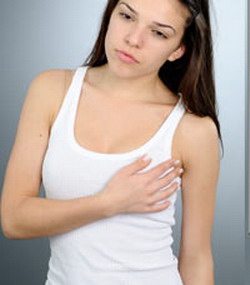
Breast pain is a common occurrence among teens and women after the onset of puberty. This is often due to hormonal changes during the monthly cycle. Changes in estrogen levels is one of the main causes of breast pain and for some can be very uncomfortable.
Many women experience breast pain every month. As many as 50 to 70 percent of women have some sort of breast pain that is either cyclical or noncyclical. Read on for more information about breast pain causes.
Types of Breast Pain
The causes of breast pain tend to fall into two categories, cyclical and non-cyclical. Here is the breakdown of what that means:
- Cyclical Breast Pain
It is the type of breast pain that is related to your menstrual cycles, pregnancy and hormonal fluctuations in your body. This type of breast pain is normal for most women and usually not associated with cancer or any serious conditions.
- Non-Cyclical Breast Pain
This type of breast pain is related to anything that is not related to hormones. This includes mastitis (infection), rib pain, caffeine use, pulled muscles, cysts, and breast cancer. If you have breast pain that does not seem related to your menstrual cycles it is a good idea to check with your doctor.
Common Causes of Breast Pain
Breast pain causes usually have to do with the menstrual cycle. There are actually a few different reasons for breast pain and these include the following:
- Hormonal Fluctuations
The hormonal swings that you get with your periods and pregnancy can cause sore and tender breasts. Even women who are going through menopause have hormone changes that can result in breast pain, especially when the estrogen levels drop. Excess emotional stress can cause the hormone levels to be thrown off and increase breast pain.
- Cysts in the Breast Tissue
Another common breast pain cause is cysts in the breast tissue. This can happen around the monthly cycle and are sacs of fluid in the breast tissue. When you do your breast self-exam you may feel small lumps that are squishy. They are usually more common during menopause and go away after all periods have stopped. If a cyst in the breast area does not go away or you have fever, contact your doctor.
- Medication Side-Effects
Some medications can cause breast pain. This includes both hormone replacements and birth control pills. The added estrogen and progesterone in these medications can throw your natural hormones off a balance leading to breast pain. There are also some antidepressants and anti-psychotics that can make your breasts tender.
- Inflamed Ribs
One of the causes of breast pain is not actually related to the menstrual cycle. Inflamed ribs can cause breast pain and is known medically as costochondritis. The inflammation has nothing to do with actual breast tissue, but actually lies in the area in between the sternum and the breastbone. This is common in mid to later years and poor posture can refer rib pain to the breasts.
- Use of Caffeine
Caffeine dilates blood vessels and is often a cause for pain anywhere in the body. Caffeinated drinks such assodas, coffee, and tea can all contribute to breast pain. Other things that contain small amounts of caffeine are chocolate and some medications. Switch to caffeine-free drinks, decaffeinated coffee or sparkling water.
- Other causes
Other causes of breast pain are things that disrupt the hormonal balance in the body. This includes the early stages of pregnancy when hormone levels are very high and the end of pregnancy when breasts can become engorged. Breast pain can also be caused by an infection known asmastitis. This needs to be treated with antibiotics. So if you have breast pain and fever, you should see your doctor. Lastly, it could be a sign of breast cancer. If you have a painful lump in your breast, it is a good idea to have it checked.
Self-help Tips for Breast Pain
If you suffer from cyclical breast pain with your monthly cycles, you can try these helpful home remedies for relief:
- Use an OTC pain reliever
Over-the-counter pain relievers can help. If it is okay with your doctor, try acetaminophen or ibuprofen.
- Invest in a good bra
Make sure your bra fits well. Breasts can become engorged from hormones and a good fitting bra can help relieve discomfort.
- Try evening primrose oil
Evening primrose taken every day for a few months can help relieve menstrual symptoms, including tender breasts. Make sure you check with your doctor because there are warnings for pregnant women or women who have seizures.
- Use a sports bra at night
Having a little support at night time can help relieve breast pain while you sleep. Also, use one of these if you exercise.
- Try topical pain relief
There are topical pain relievers that can really help with breast soreness. There are prescription anti-inflammatory creams or over-the-counter creams, just use caution around sensitive areas like nipples or open areas.
- Limit caffeine
Caffeine increases the pain sensation. Try to limit coffee, tea and foods containing caffeine like chocolate. Some pain relievers even contain caffeine.
- Use flaxseed in your diet
n Studies show that 25 grams of flaxseed daily during the menstrual cycle can help reduce the incidence of breast pain during the cycles.
- Cut down on smoking
The nicotine in cigarettes constricts blood vessels and increases inflammation in the body. Cutting back on smoking may help reduce breast pain.
When to See a Doctor
If the above self-help tips do not work, see a doctor for these symptoms:
- A change in size or shape of breasts
- Nipple discharge
- Rash on or near nipple
- The skin becomes dimpled
- Lump in the armpit
- Armpit pain that is non-cyclical
- Change in appearance of nipple
- Lump in the breast